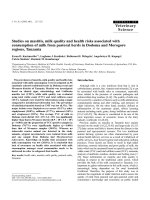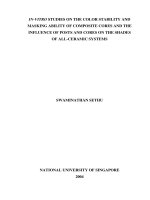Studies on egg laying behaviuor and fecundity under different stress conditions in tropical Tasar silk moth
Bạn đang xem bản rút gọn của tài liệu. Xem và tải ngay bản đầy đủ của tài liệu tại đây (152.42 KB, 6 trang )
Int.J.Curr.Microbiol.App.Sci (2019) 8(9): 1182-1187
International Journal of Current Microbiology and Applied Sciences
ISSN: 2319-7706 Volume 8 Number 09 (2019)
Journal homepage:
Original Research Article
/>
Studies on Egg Laying Behaviuor and Fecundity under Different Stress
Conditions in Tropical Tasar Silk Moth
P. Sudhakara Rao1*, K. M. Vijaya Kumari1, B. Sailaja1, G. V. Vishaka2,
S. Vidyunmala1 and R. K. Mishra3
1
Silkworm Seed Technology Laboratory, Central Silk Board, Kodathi,
Bengaluru-560035, India
2
Basic Tasar Silkworm Seed Organization, Bilaspur-495001, India
3
National Silkworm Seed Organization, Central Silk Board, Bengaluru-560068, India
*Corresponding author
ABSTRACT
Keywords
Tasar silkworm,
Antheraea mylitta,
fecundity, egg
production and
stress conditions
Article Info
Accepted:
14 August 2019
Available Online:
10 September 2019
Tasar silkworm (Antheraea mylitta Drury) rearing and cocoon production are
mainlycarried out by Tribal people of Central India and some parts of Odisha and
Telangana states. Lack of Tasar silkworm seed production and preservationtechnology
is creating difficulties in timely supply of adequate quantity of seed to the farmers and
others stake holders..High temperature above 28ºC and less relative humidity than
50% are not suitable for the oviposition and hatching of eggs. In Tasar silk moth, egg
retention was also more even after 72 h of oviposition in natural conditions.In the
present investigation, while providing optimum temperature (27-28ºC) and humidity
(75-80%) in the egg laying room, egg laying was carried out in bivoltine and trivoltine
broods under different stress conditions. The results indicated that in bivoltines (per5
moths), in T1 where antenna and wings were amputated, the number of eggs recorded
were 1306, in T2 (legs and wings cut) it were 902 and in T3 (antenna, wings & legs
cut), the number of laid eggs were 1154 when compared to 907 in Normal conditions
(T0) for 5 months. Egg retention results indicated that in T1,itwas 200 amounting to
13.28% and fecundity was 261. In T2,it was 145 amounting to 13.85 % and fecundity
was 180. In T3, with Antenna, legs & wings amputation egg retention was 135
amounting to 10.47 % and fecundity of 231.In case of normal moths (T0), egg
retention was 124 amounting to 12.03 % with a fecundity of 181. In case of
Trivoltines (5 moths) also same pattern was observed. The mentioned stress conditions
are useful while grainage operations for getting more fecundity.
Introduction
The scarcity of good quality eggs for
commercial rearing is one of the important
reasons for the decline in Tasar silk
production. In Tasar culture, pre-seed and seed
crops are affected by adverse climatic
conditions; diseases and erratic emergence in
seed cocoon as a result commercial crops are
not getting adequate timely supply of quality
1182
Int.J.Curr.Microbiol.App.Sci (2019) 8(9): 1182-1187
seed. The rearers are unable to utilize their full
potential of natural plantation for rearing
during the favorable commercial crops.
under different stress conditions of antennae /
wings amputation to realize its full potential.
Materials and Methods
Hence, there is a wide gap between the
demand and supply of disease free layings.
Lack of seed preservation technology and seed
multiplication at P2 and P1 level is weakly
integrated.
The Central Silk Board (CSB) intervening
with technological
improvements and
producing and supplying basic seed annually
to State Departments / other agencies to bring
good cocoon production through newly
established Basic Tasar Silkworm Seed
Organization (BTSSO) and its Basic Seed
Multiplication Centers (BSMTCs).
The commercial disease free layings are
distributed through private rearers and it is
necessary to preserve the produced seed and
supply for commercial crops (Singh et al.,
2014). The role of temperature and relative
humidity on oviposition and incubation of
eggs were reported earlier by several workers
(Pandeyet al.,2010). The impact of
temperature stress on hatching of eggs in
Tasar silkworm showed great deal of variation
in hatching percentage. High temperature
more than 28ºC and Relative humidity less
than 50% are not suitable for oviposition and
hatching of eggs.
The egg retention was also more in Tasar silk
moths even after 72 h of egg laying in natural
conditions of egg laying and this is one of the
factor for poor fecundity in Tasar silk moth.
Antennae are considered as nostrils in insects
to trap odor molecules (Zacharuk, 1985) and
contact chemoreception has been studied to
induce oviposition in Pieris butterflies by
glucosinolates compounds (Chapman, 1998).
In this context, the present study was carried
out to know egg laying behavior and fecundity
The required seed cocoons were obtained from
CTR&TI, Ranchi (Daba, bivoltine and
Trivoltine broods) during 2016 and preserved
under optimum conditions of temperature (2728ºC)and humidity (45-50%) recommended
for seed cocoon preservation (Singh et al.,
2014). The bivoltine and trivoltine broods
were exposed to the light regime of L: 16 h.
(4PM – 8 AM) and D: 8h. (8AM – 4 PM) one
month prior to emergence till the completion
of grainage operations and moth emergence
was recorded under this photo period.
(Vemananda Reddy et al.,2015).In the egg
laying room optimum temperature (28ºC)and
humidity (80%) were maintained for better
oviposition. The male and female moths were
left for 3-4 h coupling (Jolly et al., 1974) and
seed production was carried out under
different stress conditions i.e.,T1; Antenna&
wings amputated, T2;Legs&wings amputated
and T3; Antenna, wings & legs amputated and
T0 (Normal) and egg laying behavior was
observed. The collected eggs were incubated
at 25 ±1ºC and relative humidity of 80 ±5 %
in the SERICATRON (an environmental
chamber where required temperature and
humidity can be maintained) till hatching and
hatching percent was recorded.
Results and Discussion
In the present study the egg laying behavior
and fecundity was observed in bivoltine and
Trivoltine broods of Daba race for 5 gravid
female moths in each treatment under different
stress conditions (Table 1&2).The results
indicated that for bivoltine (Table.1) with
Antenna& wings amputation (T1) recorded
766 eggs on first day and 540 on second day
totaling to 1306 amounting to 86.72%. Egg
retention for 5 months was 200 amounting to
1183
Int.J.Curr.Microbiol.App.Sci (2019) 8(9): 1182-1187
13.28% and fecundity was 261 eggs per
month. In T2 with legs and wings amputated
indicated 539 eggs on first day and 363 on
second day totaling to 902 and amounting to
86.15 %. Egg retention was 145 amounting to
13.85 % and fecundity was 180. In T3, with
Antenna, legs & wings cut indicated 1015
eggs on first day and 139 on second day
totaling to 1154 and amounting to 89.53 %
and egg retention was 135 amounting to 10.47
% and fecundity of 231.In case of normal
moths (T0), it was indicated 682 eggs on first
day and 225 on second day totaling to 907,
amounting to 87.97 % and eggs retention was
124 amounting to 12.03 % per with a
fecundity of 213.
The results indicated for Trivoltine brood
(Table.2) with Antenna& wings amputation
(T1) recorded 781 eggs on first day and 450
on second day totaling to 1231 amounting
to95.42%. Egg retention was 59 amounting to
4.57% and fecundity was 246 eggs. In T2 with
legs and wings amputated indicated 516 eggs
on first day and 316 on second day totaling to
832 and amounting to 85.15 %. Egg retention
was 245 amounting to 25.07% and fecundity
was 166 per month. In T3, with Antenna, legs
& wings cut indicated 833 eggs on first day
and 293 on second day totaling to 1126 and
amounting to 96.98% and egg retention was
35 amounting to 3.01 % and fecundity of
225.In case of normal moths (T0), it was
indicated 582 eggs on first day and 328 on
second day totaling to 910, amounting to
86.34 % and eggs retention was 144
amounting to 13.66 % with a fecundity of
182.The weight of male, female moths, single
egg weight and eggs / g were recorded and
depicted in Table 3 indicating 95 eggs / gm
and 85 eggs / gm in bivoltine and trivoltine
respectively.
The results on hatching in bivoltines were
depicted in Table.4 indicating 91.25, 91.40,
88.95 and 90.20% in T1, T2, T3 and T0
respectively. The results on hatching in
Trivoltine indicated 91.00, 90.00, 89.00 and
90.00% in T1, T2, T3 and T0 respectively.
Quality of Silkworm seed refers to richness of
layings, egg viability and uniform hatching is
indication for good performance of the
progeny (Ullal and Narasimhanna, 1985).
Several research workers have made attempts
earlier to study different aspects of Tasar seed
preservation for skipping unfavorable seasons
(Jolly et al., 1974). Nayak and Dash (2001)
have demonstrated the influence of
climatological factors on reproduction of
Tasar silk moth.
In the present investigation, when provided
optimum temperature (27-28ºC)and humidity
(75-80%) in the egg laying room and egg
laying carried out under stress conditions,
number of eggs laid were improved in both
bivoltine and trivoltine broods. In T1 where
antenna and wings were amputated, the
number of eggs recorded were 1306, in T2
(legs and wings cut) it were 902 and in T3
(antenna, wings & legs cut), the number of
laid eggs were 1154 and when compared to
907 in Normal (T0).Egg retention was also
recorded and found to be less in treated
batches (Table.1).
In case of Trivoltine also same pattern was
observed (Table.2). In T1 where antenna and
wings were amputated, the number of eggs
recorded were 1231, in T2 (legs and wings
cut) it were 832 and in T3 (antenna, wings &
legs cut), the number of laid eggs were 1126
and when compared to 910 in Normal (T0).
The Similar results of higher egg recovery was
obtained by Kamaraj et al., (2014)where in it
was mentioned that antenna amputated Tasar
silk moths yielded more eggs during grainage
operations and have shown improved
hatching. But in the present investigation
hatching was observed almost similar in all
1184
Int.J.Curr.Microbiol.App.Sci (2019) 8(9): 1182-1187
treatments irrespective of different stress
(Table.3). Ravindra Singh et al., (2004), first
time reported 10% increase in fecundity of
antennae amputated female moths of mulberry
silkworm and also suggested to carry out
similar studies in Non-mulberry silkworms
including Tasar silkworm.
Table.1 Egg laying efficiency in Bivoltine Tasar silk moths (sample 5 moths)
1st
day
2nd
day
Antenna&
wings cut
(T1)
766
540
No
1306
(%)
86.72
No
200
Legs &wings
cut (T2)
539
363
902
86.15
Antenna,
wings & legs
cut (T3)
1015
139
1154
Normal (T0)
682
225
907
Treatments
Total laid
eggs
Egg retention in
the abdomen
Total
eggs
Fecundity
(No)
(%)
13.28
1506
261
145
13.85
1047
180
89.53
135
10.47
1289
231
87.97
124
12.03
1031
181
Table.2 Egg laying efficiency in Trivoltine Tasar moths (sample 5 moths)
Treatments
1st
day
2nd
day
Antenna&
wings cut
(T1)
Legs &wings
cut (T2)
Antenna,
wings & legs
cut (T3)
781
450
Total laid
eggs
No
(%)
1231 95.42
516
316
832
85.15
245
833
293
1126
96.98
Normal (T0)
582
328
910
86.34
Egg retention in
the abdomen
No
(%)
59
4.57
1185
Total
eggs
Fecundity
(No)
1290
246
25.07
977
166
35
3.01
1161
225
144
13.66
1054
182
Int.J.Curr.Microbiol.App.Sci (2019) 8(9): 1182-1187
Table.3 Weight of Tasar silkmoth (Average of 5 moths)
Parameters
Bivoltine
Trivoltine
Difference (%)
Weight of male moth (g)
3.986
2.342
41.24
Weight of Female moth (g)
8.286
6.998
15.54
Weight of single egg (mg)
10.52
11.30
7.41
95
85
10 (Nos)
Eggs / gram (No)
Table.4 Effect of treated eggs on hatching in Tasar silkworm
Treatments
Antenna &
wings cut (T1)
Legs and wings
cut (T2)
Antenna, wings
& legs cut (T3)
Normal (T0)
Bivoltine eggs / g.95
Eggs kept
Hatching %
475
91.25
Trivoltine eggs /g.85
Eggs kept
Hatching %
425
91.00
475
91.40
425
90.00
475
88.95
425
89.00
475
90.20
425
90.00
It is clear from the results that in treated
batches T1 and T3, where amputation of
antennae involved, the eggs laid were more
indicating importance of antenna in egg laying
when compared to other batches where
Antenna amputation was not involved (T2 and
T0). Morohoshi (2000) reported that among
the four groups of secretary cells laterally
located in the hind brain, the IV group consists
of 3 Neuro- secretary cells are directly linked
to the antennae on the head and their secretion
passes through outer axon and reaches the
corpus cardiacum where it stimulates the
organs and regulates its function.
It is concluded that when stress was given in
the form of body parts amputation, the
Neurohormones may give signal to the brain
and stimulate to lay whatever eggs remained
in the abdomen. This type of stress conditions
mentioned above may be practiced during
grainage operations of Tasar silk moth for
improved egg laying and fecundity.
Acknowledgement
The Authors are thankful to Dr.G.Vemananda
Reddy, Former Scientist D of this institute for
his valuable guidance and help during the
Study.
References
Chapman, R.F. (1998) The Insects structure
and function, Fourth edn.,Cambridge
University Press pp.8-11.
Jolly,M.S., Sen S.K., and Ahsan, M.M (1974)
Tasar culture (First edn.) Central Silk
Board, Bombay, India.pp 1-266.
Kamaraj, S; Tiwari, M.D; Minakshi, M,
Shabnam, N.K, Madhusudhan, K.N,
Serani, K Sharma, S.P and Alok Sahay
1186
Int.J.Curr.Microbiol.App.Sci (2019) 8(9): 1182-1187
(2014). Studies on effect of antenna
amputation on the fecundity and
hatching performance of tropical
tasarsilk
moths
during
grainage
operations. J.ofchem.bio.and phy.science
(JCBPS)..5(1). 960-963.
Morohoshi,
S
(2000).
Development
Physiology of Silkworms. Oxford &
IBH publishing Co. Pvt. Ltd.New Delhi,
Calcutta.
Nayak. B. M., Patro K.B.G. and Dash, M.C.
(2001). Selection of ideal grainage
house for preservation of diapausing
seed cocoons of the topical Tasar silk
moth, Antheraea paphia Linn. Bull Ind.
Acad. Seri. 5:9-15.
Pandey, J.P, P.K.Mishra, D.Kumar, B.M. K.
Singh and B.C.Prasad (2010) Effect of
Temperature on Haemocytic immune
responses of tropical Tasar Silkworm
Antheraea
mylitta
D.
Research.J.Immunol., 3: 169-177.
Ravindra Singh, Virendra Kumar, Kariappa,
B.K, Dandin, S.B and D. Raghavendra
Rao (2004). Stimulation of fecundity
through Antennal amputation in the
Mulberry silkworm, Bombyx mori L.
I.J.I.E, 8 (2): 217-219.
Ravindranath Singh, Manoj Kumar Sinha,
Chandra Mouli Bajpeyi, Ajit Kumar
Sinha, Amalendu Tikader (2014). Tasar
Culture, published by APH publishing
corporation, New Delhi.pp.266-270.
Ullal, S and Narasimhanna, M. N. (1985).
Hand book of Sericulture, Central silk
Board, Bombay, India, pp. 1-94.
Vemananda Reddy;G., Jayappa, T and
Ravindra Singh (2016) Studies on egg
production and egg handling techniques
in Tasar Silkworm Antheraea mylitta. D.
Annual report SSTL,(2015-16).,SSTL,
Central silk Board, Bangalore, India.
Zacharuk, R.Y (1985). Antennae and sensilla ;
in Comprehensive Insect Physiology,
Biochemistry and Pharmacology.6;
Kerkkut, G. A. and L.I Gilbert (eds),pp169, Oxford.
How to cite this article:
Sudhakara Rao, P., K. M. Vijaya Kumari, B. Sailaja, G. V. Vishaka, S. Vidyunmala and
Mishra, R. K. 2019. Studies on Egg Laying Behaviuor and Fecundity under Different Stress
Conditions in Tropical Tasar Silk Moth. Int.J.Curr.Microbiol.App.Sci. 8(09): 1182-1187.
doi: />
1187









